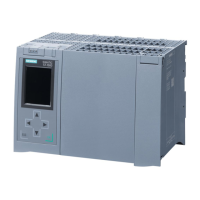Using PID_Temp
6.4 Cascade control with PID_Temp
PID control
198 Function Manual, 03/2017, A5E35300227-AC
In order to specify a setpoint, PID_Temp offers a substitute setpoint at the SubstituteSetpoint
tag in addition to the Setpoint parameter. This can be activated by setting
SubstituteSetpointOn = TRUE or by selecting the corresponding check box in the
commissioning editor.
The substitute setpoint allows you to specify the setpoint temporarily directly at the slave, for
example during commissioning or tuning.
In this case, the interconnection of the output value of the master with the setpoint of the
slave that is required for normal operation of the cascade control system does not have to be
changed in the program
In order for a master to influence the process or to carry out tuning, the substitute setpoint
has to be deactivated at all downstream slaves.
You can monitor the currently effective setpoint as it is used by the PID algorithm for
calculation at the CurrentSetpoint tag.
Operating modes and fault response
The master or slave of a PID_Temp instance does not change the operating mode of this
PID_Temp instance.
If a fault occurs at one of its slaves, the master remains in its current operating mode.
If a fault occurs at its master, the slave remains in its current operating mode. However,
further operation of the slave then depends on the fault and the configured fault response of
the master since the output value of the master is used as the setpoint of the slave:
● If ActivateRecoverMode = TRUE is configured at the master. and the fault does not
prevent the calculation of OutputHeat, the fault does not have any effect on the slave.
● If ActivateRecoverMode = TRUE is configured at the master and the fault prevents the
calculation of OutputHeat, the master outputs the last output value or the configured
substitute output value SubstituteOutput, depending on SetSubstituteOutput. This is then
used by the slave as the setpoint.
PID_Temp is preconfigured so that the substitute output value 0.0 is output in this case
(ActivateRecoverMode = TRUE, SetSubstituteOutput = TRUE, SubstituteOutput = 0.0).
Configure a suitable substitute output value for your application or activate the use of the
last valid PID output value (SetSubstituteOutput = FALSE).
● If ActivateRecoverMode = FALSE is configured at the master, the master changes to the
"Inactive" mode when a fault occurs and outputs OutputHeat = 0.0. The slave then uses
0.0 as the setpoint.
The fault response is located in the output settings in the configuration editor.

